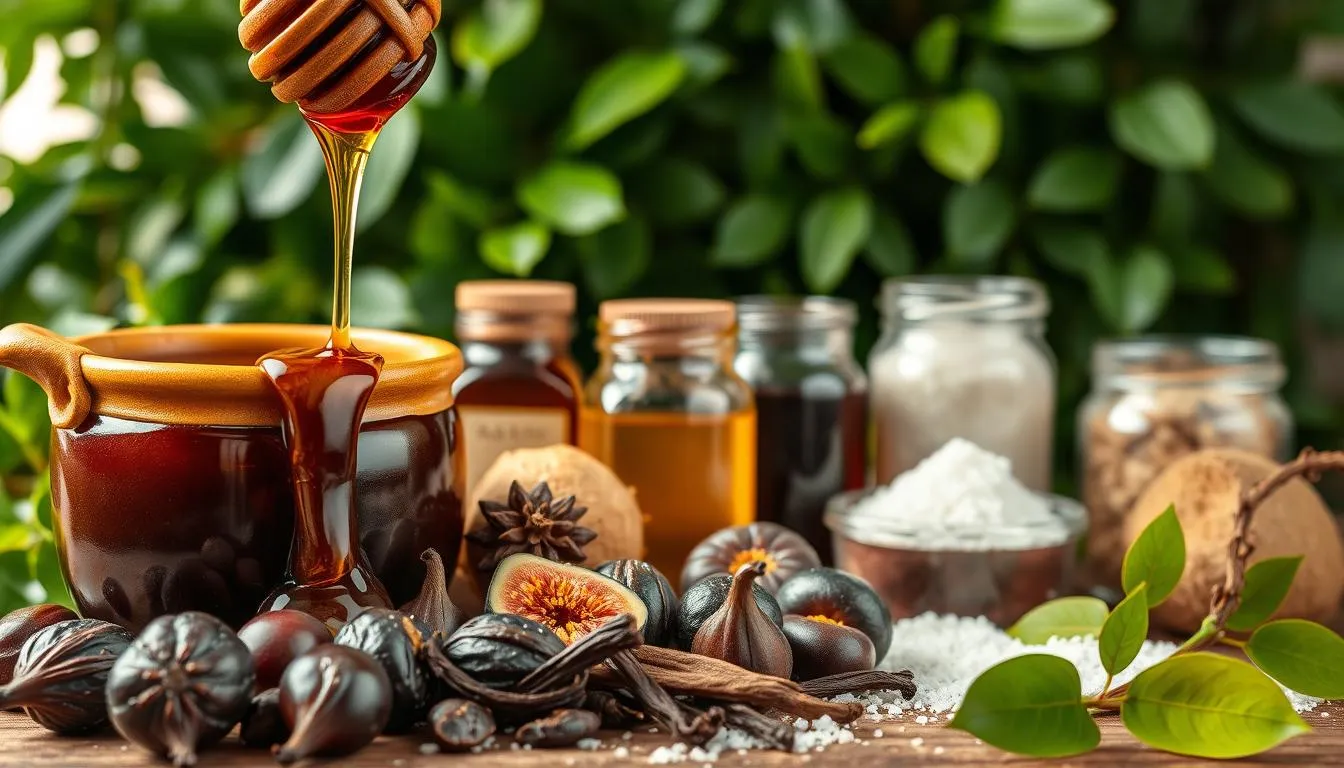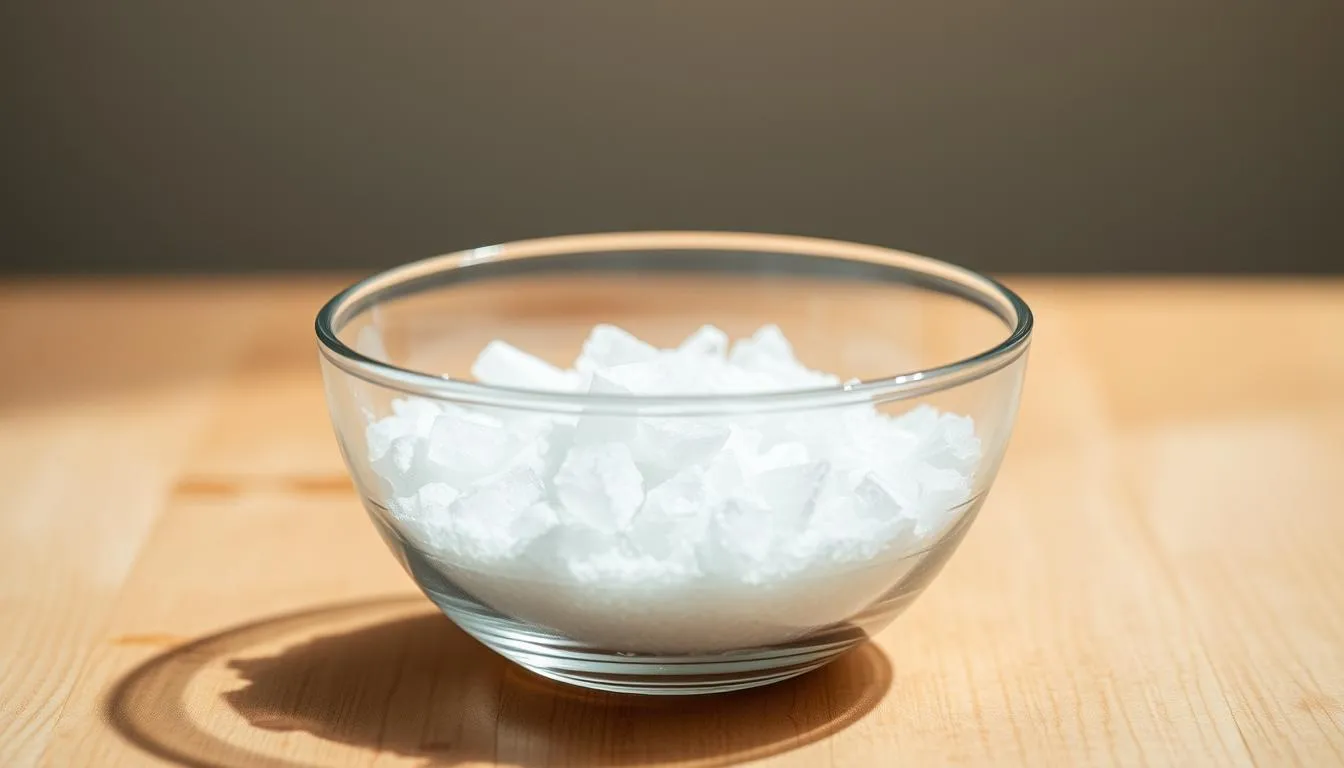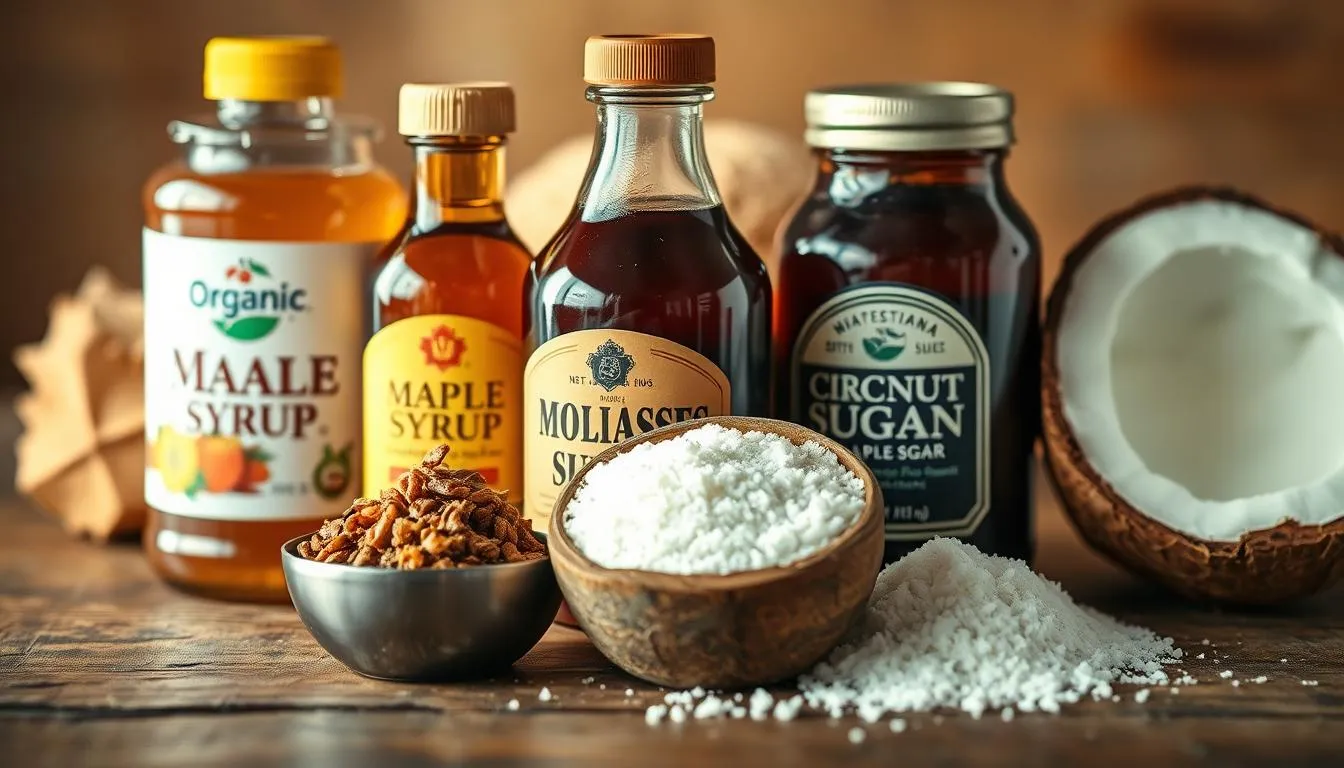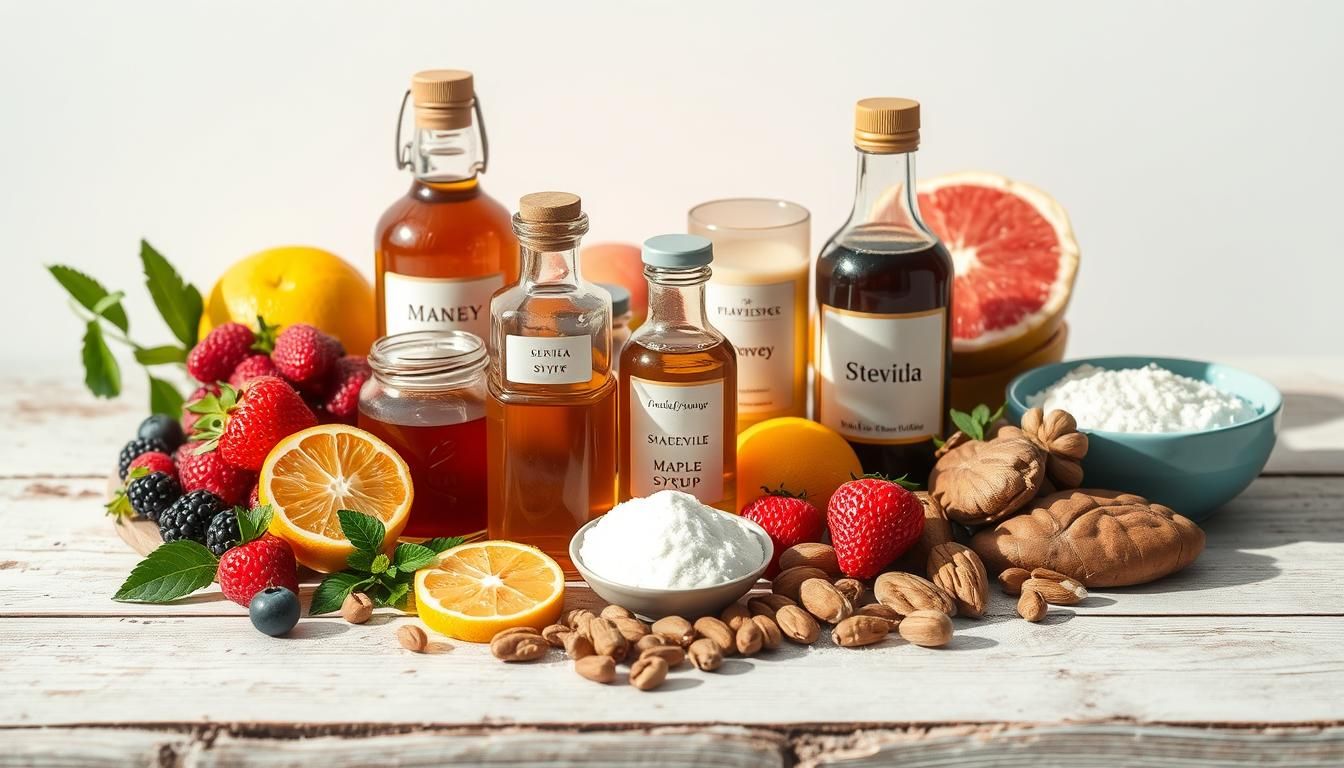I’ve stood at the grocery aisle feeling torn between taste and health. I wanted sweets that comforted me without the crash or guilt. That push led me to test smart swaps that actually fit daily life.
This listicle walks you through practical options you can use today without losing flavor. Expect tips that help your energy, appetite control, and heart health.
Well cover fresh and frozen fruit, plant-based high-intensity sweeteners like stevia and monk fruit, prebiotic choices such as yacon syrup, and whole-food substitutes like date paste. Youll also see where traditional sweeteners and sugar alcohols fit, plus how the FDA views artificial sweeteners.
My goal is a balanced mindset: not zero sugar forever, but informed swaps that lower added sugar while keeping meals enjoyable and realistic for most people. Read on for recipe conversions, label literacy pointers, and easy everyday swaps for drinks and snacks.
Key Takeaways
- Smart swaps can steady energy and aid appetite control.
- Fruit and whole-food substitutes add fiber and vitamins.
- High-intensity sweeteners offer few calories but vary in use.
- Read labelsblends and fillers change results in recipes.
- Choose based on personal goals like weight, diabetes, or dental health.
Why cutting added sugar matters right now
Small daily amounts of added sweeteners add up quickly and change how your body handles food. Over time, extra calories from added sugar promote weight gain by increasing appetite and making it easier to overeat.
High intakes link to higher risk of type 2 diabetes, heart disease, fatty liver, and dental decay. Many studies show consistent patterns of overconsumption raise blood sugar swings and metabolic markers that strain the heart and body.
Know the limits: the American Heart Association recommends no more than 25 g (6 tsp) daily for women and 36 g (9 tsp) for men. The average U.S. intake is about 68 g per day, well above those targets.
Not all sugars are the same. Whole fruits contain natural sugars plus fiber and nutrients, while added sugars in processed foods and drinks lack that balance and add empty calories.
- Frequent exposure to intense sweetness can condition cravings and make sweet foods more desirable.
- Read labelsflavored yogurts, cereals, sauces, and beverages often hide added sugars.
- Try small changes: cut a teaspoon from coffee, dilute juice with water, or choose plain yogurt and add fruit.
Bottom line: research consistently suggests that lowering added sugar supports heart and metabolic health for most people. Small, steady changes help bring intake toward AHA guidance and reduce longterm risk.
Top picks: Reducedsugar alternatives that satisfy and support health
Smart picks for sweeteners let you enjoy desserts while adding fiber, vitamins, or prebiotic support. This section highlights practical options that keep flavor and bring real health benefits.

Fresh and frozen fruit for natural sweetness and fiber
Fruit is the easiest first choice. It sweetens oatmeal, smoothies, yogurt, and baked goods while adding fiber, vitamin C, potassium, and antioxidants.
Use mashed banana in muffins or blend frozen berries into smoothies to cut added sugar and boost nutrients.
Stevia: high potency with nearzero calories
Stevia from Stevia rebaudiana is hundreds of times sweeter than table sugar and has almost no calories. Some human studies show it can help support blood sugar control and, in people with high blood pressure, may lower readings.
Taste varies by brand, so try small amounts or blends to find what you like.
Monk fruit extract: mogrosides and caloriefree sweetness
Monk fruit provides no calories and contains antioxidant mogrosides. It can be a good sweetener for drinks and recipes.
Check labels because some products may contain added sugars or sugar alcohols that change taste and nutrition.
Yacon syrup: prebiotic fructooligosaccharides
Yacon syrup is rich in fructooligosaccharides, a prebiotic fiber that feeds gut bacteria and may help regularity. A small drizzle on yogurt or cereal gives flavor plus digestive support.
Large servings can cause gas or diarrhea, so start small.
Date paste: fiberrich, wholefood sweetener
Date paste adds vitamins, minerals, and moisture to baked goods. Its sweeter than sugar, so reduce added liquids in recipes.
Make a simple paste by blending soaked dates with a bit of warm water and use it to sweeten sauces or bars.
- Quick ideas: mash banana for muffins, stir stevia or monk fruit into iced tea, drizzle yacon syrup, or swap date paste into sauces.
- Keep portions mindfulconcentrated sweetness still contributes calories and affects taste.
- For more context on practical substitutes, see the best and worst sugar substitutes.
Natural sweeteners: whats better, what to watch
Natural sweeteners can add flavor and small nutrients, but they often behave like added sugar in the body. Use them thoughtfully and keep portions modest.
Maple syrup: antioxidants and minerals, but still added sugar
Pure maple syrup contains antioxidants and trace minerals like calcium, potassium, iron, zinc, and manganese. Those benefits are real, but maple acts like added sugar and adds calories.
Choose 100% maple and read labels carefully. Many pancake syrups may contain highfructose corn syrup or other fillers that you may want to avoid. Treat maple as a flavorful treat and use small amounts.
Honey: nutrients, prebiotics, and an important safety note
Honey provides antioxidants, minerals, vitamins, and oligosaccharides that can support gut flora. It breaks down to glucose and fructose, so it still contributes calories and can raise blood sugar when overused.
Infant safety: never give honey to babies under 12 months because of the risk of botulism spores.
Coconut sugar and agave nectar: flavor perks, fructose concerns
Coconut sugar is less refined and keeps some minerals, but it has similar calories to table sugar and still raises calorie intake. Agave nectar tastes mild and sweet, yet it is very high in fructose even more than some corn syrups which can be a concern for metabolic health.
| Sweetener | Pros | Cons |
|---|---|---|
| Maple syrup | Antioxidants, trace minerals | High calories; may contain corn syrup if not pure |
| Honey | Nutrients, prebiotic oligosaccharides | Calories; can raise blood sugar; unsafe for infants <1 year |
| Coconut sugar / Agave | Distinct flavor; less processed image | Similar calories; agave high in fructose |
- Use with moderation: these sweeteners add flavor but can contribute to excess intake when poured freely.
- Kitchen tips: reduce added liquid when swapping syrups, use small drizzles for glazes, and boost flavor with spices or citrus instead of more sweeteners.
Sugar alcohols: sweet taste with fewer blood sugar spikes
Sugar alcohols are a type of lowdigestible carbohydrate that gives sweetness with fewer calories absorbed and a smaller effect on blood sugar. They can be useful for people with diabetes when used sensibly and in sensible amounts.

Erythritol profile and a cautious note
Erythritol tastes close to sugar, has a very low glycemic impact, and is mostly excreted unchanged in the urine rather than metabolized by the body. Most people tolerate normal servings well, but very large amounts may cause gas or diarrhea.
One small study linked higher blood levels of erythritol with cardiac events, but that finding was associative. More research needed before drawing firm conclusions from those studies.
Xylitol: dental perks plus important pet warning
xylitol matches sugar’s sweetness, can reduce cavity risk, and may support the gut microbiome. High doses can cause bloating or loose stools, so start with small servings and space them out.
Strong warning: xylitol is highly toxic to dogs. Store all products securely and never offer xylitolcontaining foods to pets.
- Practical uses: try erythritol in cold drinks and chilled desserts, use xylitol where bulk matters in baking, or blend sweeteners to balance taste and texture.
- Learn more about safe use and tips in the guide on what to know about sugar alcohols.
Artificial sweeteners: pros, cons, and what current research says
Artificial sweeteners offer intense sweetness with almost no calories, but they come with tradeoffs to consider.
Sucralose and AceK: FDA status, heat stability, and usage
Sucralose is roughly 600x sweeter than sugar and AceK about 200x. Both are FDAapproved and heatstable, so manufacturers use them in cooking, baking, and many packaged foods.
Baking blends that include sucralose help replace bulk and texture, not just sweetness. That makes them more useful in recipes that need volume.
Cravings, metabolic questions, and why moderation still matters
These sugar substitutes usually do not raise blood sugar and can lower calories when used thoughtfully. That can help people with diabetes or those tracking carbs under medical guidance.
Yet research is mixed. Some observational studies link frequent use to higher risk of weight gain and cardiometabolic issues, including heart disease, but causality is unclear. Lifestyle and diet patterns likely play a role.
“Use sweeteners as tools, not replacements for a foodfirst approach.”
Some people find very sweet tastes keep cravings for foods like sugar. Monitor how you respond and aim for moderation.
- Pros: nearzero calories, heat stable, FDA approved.
- Cons: mixed longterm evidence, possible craving effects, and lifestyle confounders in studies.
Bottom line: artificial sweeteners and sugar substitutes can be useful, but prioritize whole food choices and use these sweeteners sparingly as part of a balanced plan.
Reducedsugar alternatives for home cooking and baking
Smart swaps for cooking and baking hinge on matching sweetness, bulk, and heat stability.

Sweetness conversions and liquid-to-dry adjustments
When replacing table sugar with honey or maple syrup, use about 3/4 cup of syrup for each cup of sugar and cut other liquids by 3 tablespoons per cup.
Why it matters: honey and syrup add water and are sweeter per volume, so lowering the total amount keeps batters balanced and prevents soggy crumbs.
Blending sweeteners to improve taste and texture
Highintensity sweeteners like stevia and monk fruit are 200300x sweeter than sugar. Start with tiny amounts and taste as you go.
Blend a highpotency sweetener with erythritol or a small amount of date paste to add bulk, improve browning, and cut aftertaste.
Heat stability: what works in the oven vs. at the table
Sucralose and AceK are heatstable and suit baking. Stevia is relatively heatstable too, but some liquid blends work best in cold drinks, coffee, or finishing sauces.
Skip heavy reliance on substitutes for recipes that need caramelization, like toffee. Instead use them in custards, cheesecakes, muffins, and sauces where texture matters more than caramel color.
| Swap | Ratio / Tip | Best uses |
|---|---|---|
| Honey or maple syrup | cup syrup = 1 cup sugar; reduce liquids 3 tbsp/cup | Muffins, sauces, glazes |
| Stevia / Monk fruit | Start tiny; blend with 1:1 bulk sweetener like erythritol | Cold desserts, beverages, baked goods with added bulk |
| Sucralose / AceK | Use per package conversion; heat stable | Baking, cooked sauces, packaged recipe swaps |
- Track the amounts you use to finetune sweetness and calories across weekly cooking.
- Test small batches before changing a full recipe to protect texture and flavor.
Smart label reading to avoid hidden added sugar
Labels tell the real story: ingredients, not marketing words, decide whats inside. Start by scanning the Nutrition Facts line for Added Sugars. That number shows how much of the products sweetening is extra, not naturally in the food.
Spot ingredient red flags
Turn the package and read ingredients. Watch for corn syrup, cane sugar, dextrose, and fruit juice concentrates. Many pancake or maple syrup bottles are flavored and include highfructose corn syrup instead of pure syrup or honey.
Watch blended sweetener labels
Monk fruit and stevia packets often carry fillers like erythritol or maltodextrin. Those fillers change texture, taste, and calories. Check if a product says may contain or lists other sweeteners that affect tolerance.
Track sugar alcohols and total amounts
Look for erythritol, xylitol, or sorbitol in the ingredient list. Sugar alcohols show up in many sugarfree foods and beverages. People can get GI discomfort when totals are high, so note serving sizes and cumulative amounts.
Quick tips: compare brands for simpler ingredient lists, pick items labeled 100% pure when you want real maple or honey, and keep a short pantry list of trusted staples to control daily intake. Use research and label clues to pick betterforyou sweeteners and sugar substitutes.
Blood sugar and weight: choosing substitutes for your goals
When managing glucose or trimming calories, the right sweetener can help but it wont do the whole job.
How sweeteners affect blood sugar: Stevia and monk fruit generally do not raise blood sugar and can aid people with diabetes when used in place of added sugars. Sugar alcohols such as xylitol have a smaller glycemic effect but may cause digestive upset in larger amounts.
Natural syrups like honey, maple, and agave raise glucose and deserve sparing use for diabetes or strict carb targets.
Weight and cravings: Cutting added sugar and lowering overall calories supports weight goals. Yet ultrasweet tastes may keep cravings alive, so people often do better by reducing sweetness over time instead of switching only to very intense sweeteners.
Dental and heart context: Xylitol can reduce cavity risk and is a smart pick in gum or mints. Lowering added sugars and refined carbs also supports heart health when paired with movement, fiber, and whole foods.
Test what works: Track your energy, hunger, and digestion after trying a new option. Keep the choices that deliver benefits without side effects.
| Goal | Good choices | Use cautions |
|---|---|---|
| Blood sugar control | Stevia, monk fruit, lowimpact sugar alcohols | Avoid frequent use of honey, maple, agave |
| Weight management | Lowcalorie sweeteners; lower overall sweetness | Ultrasweet tastes may maintain cravings |
| Dental health | Xylitol (gum, mints) | Keep portions; xylitol is toxic to dogs |
| Heart and metabolic risk | Reduce added sugars, choose fiberrich foods | Relying only on sweeteners without diet change limits benefits |
Practical takeaways: prioritize whole foods, lean protein, healthy fats, and fiber. Use sweeteners as small tools within a balanced diet and consult resources like this guide on sugar and substitutes when you need deeper context.
Simple swaps to lower sugar intake today
Simple kitchen tweaks let you enjoy favorite foods while trimming daily sugar. Small changes at meals and snacks add up and can protect weight and heart health without making food boring.
Upgrade beverages, yogurt, cereals, and snacks
Replace sodas and sweet teas with water infused with citrus, berries, or mint. For fizz, mix sparkling water with a splash of 100% juice.
Choose plain Greek yogurt and stir in chopped fruit, cinnamon, or vanilla. This cuts added sugar and boosts protein and fiber.
Pick unsweetened cereals or oatmeal and top with banana slices or thawed frozen fruit for natural sweetness and texture.
- Switch candy for a warm cocoa made with unsweetened cocoa, a noncaloric sweetener, and milk to lower calories.
- For coffee and tea, try stevia or monk fruit drops, or use a light touch of pure maple syrup or honey while tracking amounts.
- Keep nuts, cheese sticks, wholegrain crackers, and fresh fruit handy to avoid ultraprocessed sweets between meals.
- Use spices, extracts, and citrus zest to build flavor without added sugar.
| Swap | Why it helps | Quick tip |
|---|---|---|
| Soda Infused water | Fewer calories; lowers sugar intake | Use lemon, mint, or berries |
| Sweet yogurt Plain + fruit | Less added sugar; more protein | Stir in chopped fruit and cinnamon |
| Sweet cereal Unsweetened oats | More fiber; steady energy | Top with banana or frozen fruit |
| Candy Hot cocoa | Lower calories; satisfying treat | Use unsweetened cocoa and milk |
Remember: WHO notes nonsugar sweeteners are not a longterm weight fix. Focus on whole foods, smart swaps, and steady habits to improve health and lower sugar intake for good.
Conclusion
Let real food lead your plate, and treat sweeteners as occasional tools rather than daily habits.
Focus on whole, nutrientdense foods first and lean on fruit and other natural sweeteners for flavor and fiber. Use stevia, monk fruit, or sensible sugar alcohols like xylitol to lower calories and added sugar intake when needed.
Maple syrup and honey bring some benefits but add sugar and calories, so measure portions. People with diabetes or heart concerns should track blood responses and pick an alternative that fits their goals.
Research keeps evolving. Stay curious, read labels, and favor moderation. Small, steady changes in drinks, breakfasts, and snacks deliver real health benefits over time without losing the flavors you love.
FAQ
What are good lowadded sugar options to replace regular table sugar?
Choose whole fruit, date paste, or small amounts of maple syrup or honey for flavor and nutrients. For calorie-free sweetness, stevia and monk fruit work well. Sugar alcohols like erythritol and xylitol give bulk and sweetness with fewer calories, but watch for digestive effects. Match the choice to your cooking needs and blood sugar goals.
Will natural sweeteners like honey or maple syrup raise blood sugar as much as white sugar?
They can raise blood glucose because they contain sugars, but fruit, honey, and maple syrup add small amounts of vitamins, minerals, or antioxidants. Honey and maple still count as added sweetener, so portion control mattersespecially for people managing diabetes or weight.
Are zerocalorie sweeteners such as stevia and monk fruit safe for everyday use?
Yes, stevia and monk fruit are generally safe and have no calories. Studies suggest they dont raise blood glucose, and stevia may even help with blood pressure for some people. However, longterm research continues, so use them in moderation and check product labels for added fillers.
What are sugar alcohols, and do they affect blood sugar?
Sugar alcohols like erythritol and xylitol provide sweetness with fewer digestible carbs. Erythritol has minimal glycemic impact, while xylitol raises blood glucose slightly. Both can cause gas or loose stools when eaten in large amounts, and xylitol is toxic to dogs, so store carefully.
Can artificial sweeteners such as sucralose or acesulfame potassium (AceK) help with weight loss?
They reduce calories compared with sugar, which can support weight goals if they replace highcalorie foods. Some studies raise questions about cravings and metabolic effects, so they arent a guaranteed shortcut. Focus on overall diet quality and portion sizes.
Is date paste a good option for baking instead of refined sugar?
Yes. Date paste adds sweetness, fiber, and minerals, and it performs well in many baked goods. You may need to reduce added liquid because it adds moisture, and check sweetness levelsdates are less sweet than concentrated syrups per volume.
How should I convert recipes when using a liquid sweetener like honey or yacon syrup?
Reduce other liquids slightly when using liquid sweeteners and lower oven temperature by about 25F if the sweetener browns faster. Use conversion charts for volume swapsliquid sweeteners often measure differently than granulated sugarand experiment in small batches until texture and taste match.
Are there cardiovascular risks linked to sugar substitutes like erythritol?
Some research has flagged associations that need more study, but current regulatory agencies still consider approved sweeteners safe. If you have heart disease risk factors, discuss sweetener choices with your clinician and favor whole foods and fiberrich options overall.
How do I read labels to avoid hidden added sugars and may contain fillers?
Look for terms like maltodextrin, corn syrup, dextrose, fruit juice concentrate, and syrups. Check ingredient orderitems listed first are most abundant. For sugar alcohol blends or sweetener mixes, a may contain statement can indicate fillers or added sugars; choose singleingredient products when possible.
Which sweeteners are best if Im managing diabetes or watching blood glucose?
Stevia, monk fruit, and erythritol have low glycemic impact. Fresh fruit adds fiber that slows glucose spikes. Limit honey, maple, agave, and coconut sugar because they can raise blood glucose. Always monitor your response and work with a dietitian or endocrinologist for individualized advice.
What should I watch for when using coconut sugar or agave nectar?
They offer distinct flavors and trace nutrients, but both are high in fructose or fructoserich sugars, which can affect insulin sensitivity and liver metabolism if overused. Use them sparingly and balance with fiber and protein in meals.
Can sweetener blends give a more sugarlike taste and texture in baking?
Yes. Combining erythritol with a small amount of stevia or monk fruit often improves taste and reduces aftertaste. Adding a bit of fat or fiber (like nut flour) helps mimic sugars texture. Trial and error yields the best results for your recipes.
Are there safety concerns about giving honey or other sweeteners to infants?
Yes. Do not give honey to infants under 12 months due to the risk of infant botulism. Sweeteners intended for older children and adults may be safe, but always follow pediatric guidance on introduced foods.
Do natural sweeteners provide health benefits compared with refined sugar?
Some do offer antioxidants, minerals, or prebiotic fibersmaple syrup has minerals and antioxidants, yacon syrup contains fructooligosaccharides that support gut bacteriabut benefits are modest. Consider them as occasional flavor enhancers rather than health staples.
How can I cut overall added sweetener intake without losing flavor?
Start by reducing sweetener amounts gradually, boost flavor with spices (cinnamon, vanilla), use citrus zest, choose plain yogurt or unsweetened drinks and add fruit for natural sweetness. Small swapsunsweetened cocoa, flavored extracts, or mashed berriesdeliver satisfaction with fewer added sugars.
